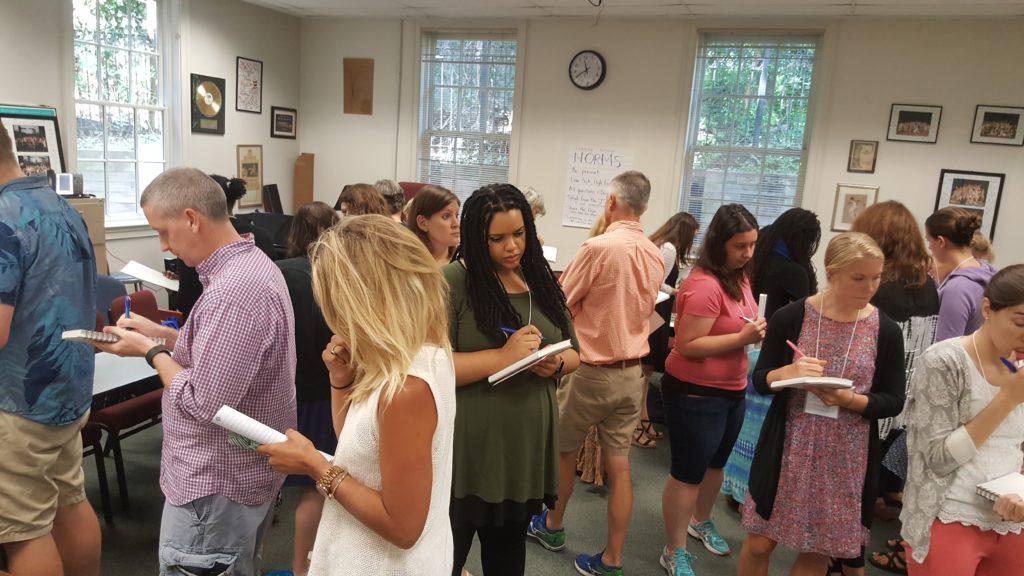WISSIT Reflection: Teacher Christmas in July
This blog post is by Sher Anderson Petty, an English Literature teacher at Springbrook High School in Montgomery County, MD.
In 2017, after 22 years teaching, thousands of hours honing my craft, countless trainings to grow as a teacher (of students grades 7-12 and teachers working toward professional certification), and years of “teaching like my hair was on fire” with all of the radical authenticity and vulnerability I could muster, I felt stagnant in my professional development as an educator. To make matters worse, my students’ exam scores were languishing around the global mean, stubbornly in opposition to all of our considerable efforts. I felt heavy with the weight of disappointment (mine, my kids’, and my administrators’) when I arrived at WISSIT. As an educator, I felt utterly spent.
After years of professional peers trying to get me to attend WISSIT, I decided that 2017 would be the year I would apply to attend. All that I heard about it suggested that it might be just the professional development to nourish my starving teacher brain.
From the moment I arrived, I felt excited with the anticipation of a kid about to open gifts on Christmas day. I hoped that I’d be opening gifts that would be better than the one-size-fits-all trainings that I’d been forced to squeeze my substantial professional self into for years. I hoped that I would figuratively get to taste something delicious and good for my malnourished teacher-self. I silently prayed, “No more newbie pablum and milk toast, please God! I’m really hungry! Give me something that I can sink my teeth into. Give me something to help me grow.”
My prayers were answered as I was thrilled to discover that WISSIT was teacher Christmas every single day. There was truly something for everyone (from newbie to veteran). I did not find even one course ill-suited for a teacher of my professional plus-size. I did not find one dish on the WISSIT menu of classes that tasted like bland blah-blah or newbie-teacher pablum to my seasoned professional palate. In my learning group and in my courses, I found an educator’s dream buffet that delighted my senses, piqued my curiosity, and fed me both as a learner and as a teacher:
1. Ron Ritchhart’s plenary session, “Creating a Culture of Thinking Right from the Start: 10 things to Say Every Day to Your Students” reaffirmed the value of some of the best practices I have woven into the fabric of the class culture (like greeting students, asking students to explain the rationale behind their arguments, and perspectives with interest and caring).

2. Learning Group D, under the facilitation of Terry Thomas, Elizabeth Dean, and Marilyn Odhiambo-Wilson, gave me new ideas for building a class climate that supports belonging. From crafting research questions, to playing classical music to relax anxious learners, to the watercoloring as reflective practice, to the closing day presentations each day was chock-full of teaching excellence that I look forward to pulling from.
3. Kerri Redding’s course, “Using Media to Make Thinking Visible” will be most useful for engaging in challenging or difficult conversations in my AP Language Arts classes where my curriculum centers on equity and social justice issues. Her deft use of thinking routines (Headlines, Circle of Viewpoints, Unveiling Stories, Step Inside & Think, Feel, etc.), digital technology (pear deck), and her courageous choice of media (Proctor & Gamble, “The Talk”) inspires me to make intentional space for conversations on recent controversies that will be relevant to my students. I aspire to her seamless integration of thinking routines to support the analysis and synthesis of media content in my classes this year.

4. Kara Kling’s, “Using Global Thinking Routines to Promote Empathy and Equity in the Classroom” will be useful in my efforts to support my school’s improvement plan goals to foster a greater sense of belonging in our school culture. I will practice using Circle of Viewpoints and Tug of War to generate empathy and practice equitable teaching practices. I sincerely appreciated her offer to keep in touch when I expressed nervousness about integrating the thinking routines.
5. Gwen Fernandez’s “Sketching for Understanding” pulled me out of my comfort zone in a good way. I can see how the reassurance that drawing experience is not needed for these routines helped me relax when comparing my work to others and just be in my own process. I intend to practice slowing down and sketching to cultivate dispositions of observing, comparing, and connecting in my class this year.
6. Heidi Hinish’s, “Exploring Global Connections through Art” left me with lots of ideas for introducing various written texts that I teach through the observation, description, analysis, and questioning of related art. I’m excited to introduce a study of excerpts from The Great Gatsby using surrealist art from the roaring ‘20s.

Even after my WISSIT week and my first week back at school for the 2017-2018 school year, I was still feeling intellectually stimulated and professionally reinvigorated. I have already shared Project Zero (PZ) thinking routines and ideas in my various capacities as high school teacher, teacher trainer and leader. I am committed to participating in DC-PZ activities, creating MC-PZ (Montgomery County-PZ) interest, and taking Harvard Project Zero courses to keep the spirit of my teacher Christmas alive. As I enter my 23rd year working as an educator, my WISSIT 2017 experience has renewed my faith in the power of a good education and reignited my curiosity and interest in my profession.
I am grateful for the gift of fresh eyes using a Project Zero perspective and the amazing PZ ecosystem (WISSIT/ DC-PZ/ MCP-Z) within which I may continue to grow. Thanks, WISSIT, for the teacher Christmas gift that Project Zero continues to be for me!